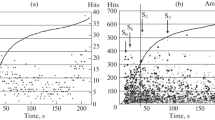Abstract
Mechanical abrasion followed by transmission delta-haze measurement is a standard means to assess wear in polymeric silicone automotive hard coatings. However, the drawbacks of this abrasion–transmission (A–T) technique (drift, variability, sample size, and test time) make an alternative measurement method desirable. Literature reports have shown that the ratio of hardness to modulus can successfully predict wear performance in ceramic and metallic nanocomposite coatings. This work studied measures from both nanoindentation and nanoscratch testing to determine which could be a viable alternative to the historical A–T test for a specific polymeric coating system. Both nanoindentation measures of hardness (H) and the ratio of hardness to modulus (H/E r) showed high repeatability compared with the other measures evaluated in this study and compared with the historical test. Of these two measures, the ratio H/E r with an exponential fit showed the strongest correlation with A–T delta-haze measurements. Key formulation and process factors affecting abrasion resistance in automotive coatings were analyzed in a designed experiment with historical A–T delta-haze and nanoindentation H/E r as responses. Analysis showed significant benefits to the use of the H/E r measure of abrasion resistance in modeling coating performance.








Similar content being viewed by others
References
Leyland, A, Matthews, A, “On the Significance of the H/E Ratio in Wear Control: A Nanocomposite Coating Approach to Optimized Tribological Behavior.” Wear, 246 1–11 (2000)
Leyland, A, Matthews, A, “Design Criteria for Wear-resistant Nanostructured and Glassy-metal Coatings.” Surf. Coat. Technol., 177–178 317–324 (2004)
Beake, BD, Vishnyakov, VM, Harris, AJ, “Relationship Between Mechanical Properties of Thin Nitride-based Films and Their Behavior in Nano-scratch Tests.” Tribol. Int., 44 468–475 (2011)
Guruvenket, S, Li, D, Klemberg-Sapieha, JE, Martinu, L, Szpunar, J, “Mechanical and Tribological Properties of Duplex Treated TiN, nc-TiN/a-SiNx and nc-TiCN/a-SiCN Coatings Deposited on 410 Low Alloy Stainless Steel.” Surf. Coat. Technol., 203 2905–2911 (2009)
Wen, SP, Zong, RL, Zeng, F, Guo, S, Pan, F, “Nanoindentation and Nanoscratch Behaviors of Ag/Ni Multilayers.” Appl. Surf. Sci., 255 4558–4562 (2009)
Hsu, C-H, Chen, Y-D, “A Study on the Abrasive and Erosive Wear Behavior of Arcdeposited Cr-N-O Coatings on Tool Steel.” Thin Solid Films, 517 1655–1661 (2009)
Ghosh, SK, Limaye, PK, Bhattacharya, S, Soni, NL, Grover, AK, “Effect of Ni Sublayer Thickness on Sliding Wear Characteristics of Electrodeposited Ni/Cu Multilayer Coatings.” Surf. Coat. Technol., 201 7441–7448 (2007)
Zhang, P, Wang, L, Nie, X, “Tribological Properties of a-C/Cr(N) Coatings in Micro- and Nano-scales.” Surf. Coat. Technol., 201 5176–5181 (2007)
Caro, J, Curadrado, N, Gonzalez, I, Casellas, D, Prado, JM, Artus, P, Peris, S, Carrilero, A, Dursteler, JC, “Microscratch Resistance of Ophthalmic Coatings on Organic Lenses.” Surf. Coat. Technol., 205 5040–5052 (2011)
Wu, LYL, Chwa, E, Chen, Z, Zeng, XT, “A Study Towards Improving Mechanical Properties of Sol-gel Coatings for Polycarbonate.” Thin Solid Films, 516 1056–1062 (2008)
Charitidis, C, Laskarakis, A, Kassavetis, S, Gravalidis, C, Logothetidis, S, “Optical and Nanomechanical Study of Anti-scratch Layers on Polycarbonate Lenses.” Superlattices Microstruct., 36 171–179 (2004)
Amerio, E, Fabbri, P, Malucelli, G, Messori, M, Sangermano, M, Taurino, R, “Scratch Resistance of Nano-silica Reinforced Acrylic Coatings.” Prog. Org. Coat., 62 129–133 (2008)
Ballarre, J, Jimenez-Pique, E, Anglada, M, Pellice, SA, Cavalieri, AL, “Mechanical Characterization of Nano-reinforced Silica Based Sol-gel Hybrid Coatings on AISI 316L Stainless Steel Using Nanoindentation Techniques.” Surf. Coat. Technol., 203 3325–3331 (2009)
Tiwari, A, Hihara, LH, “Effect of Inorganic Constituent on Nanomechanical and Tribological Properties of Polymer, Quasi-ceramic and Hybrid Coatings.” Surf. Coat. Technol., 206 4606–4618 (2012)
Sinha, SK, Chong, WLM, Lim, S-C, “Scratching of Polymers—Modeling Abrasive Wear.” Wear, 262 1038–1047 (2007)
Douce, J, Boilot, J-P, Biteau, J, Scodellaro, L, Jimenez, A, “Effect of Filler Size and Surface Condition of Nano-sized Silica Particles in Polysiloxane Coatings.” Thin Solid Films, 466 114–122 (2004)
Rodriguez, J, Rico, A, Soria, V, “Tribological Properties of Commercial Optical Disks Estimated from Nanoindentation and Scratch Techniques.” Wear, 263 1545–1550 (2007)
Nemeth, S, Liu, YC, “Mechanical Properties of Hybrid Sol-gel Derived Films as a Function of Composition and Thermal Treatment.” Thin Solid Films, 517 4888–4891 (2009)
Oliver, WC, Pharr, GM, “Measurement of Hardness and Elastic Modulus by Instrumented Indentation: Advances in Understanding and Refinements to Methodology.” J. Mater. Res., 19 3–20 (2004)
Cheng, Y-T, Cheng, C-M, “Scaling, Dimensional Analysis, and Indentation Measurements.” Mater. Sci. Eng. R., 44 91–149 (2004)
Choi, Y, Lee, H-S, Kwon, D, “Analysis of Sharp-tip Indentation Load-depth Curve for Contact Area Determination Taking into Account Pile-up and Sink-in Effects.” J. Mater. Res., 19 3307–3315 (2004)
Tsui, TY, Pharr, GM, Oliver, WC, Bhatia, CS, White, RL, Anders, S, Anders, A, Brown, IG, “Nanoindentation and Nanoscratching of Hard Carbon Coatings for Magnetic Disks.” Mater. Res. Soc. Symp. Proc., 383 447–452 (1995)
Holberg, K, Ronkainen, H, Laukkanen, A, Wallin, K, “Friction and Wear of Coated Surfaces—Scales, Modeling, and Simulation of Tribomechanisms.” Surf. Coat. Technol., 202 1034–1049 (2007)
Acknowledgments
The authors are grateful to Venkat Raghuram Rao Gangaraju of Momentive and Bernard Becker and Anqi Qiu of Hysitron, Inc. for helpful discussions on statistical methods of analysis. Additional thanks go to Thomas Ford of Momentive for making the abrasion–transmission measurements reported in this paper.
Author information
Authors and Affiliations
Corresponding author
Rights and permissions
About this article
Cite this article
David, J., Hayes, R., Hui, J. et al. Nanoindentation as an alternative to mechanical abrasion for assessing wear of polymeric automotive coatings. J Coat Technol Res 13, 677–690 (2016). https://doi.org/10.1007/s11998-016-9782-8
Published:
Issue Date:
DOI: https://doi.org/10.1007/s11998-016-9782-8




